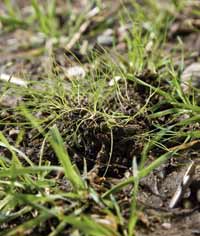Spring annual meadowgrass options

Opportunities for applying residual herbicides in the autumn were limited for some growers who will have to rely on spring treatments to control annual meadowgrass.
Growers in central Scotland were hit particularly hard by late-autumn weather and consequently very little has been sprayed, says Jim Rennie, technical director for CSC Crop Protection.
“Growers were very busy sowing and consequently they managed to get a lot more crop in the ground,” he says. “But by the time they had finished spray opportunities were limited.”
Where autumn residuals have been applied meadowgrass control is good, he says. “Pre-emergence mixes of pendimethalin and chlorotoluron have worked very well, as have early post-emergence Defy mixes,” he says.
Control has been easier than expected given the loss of the key annual meadowgrass killer IPU, he says. “We’re missing IPU, but less than we thought we would – the only problem has been variety intolerance to chlorololuron.”
Later-drilled crops after potatoes and vegetables are not suffering from annual meadowgrass competition as the cold winter and late drilling has held the weed back.
But early-drilled stands have significant populations, some already fully tillered. It’s disappointing that some of the early-planted crops didn’t receive pre-emergence residuals as autumn residuals give more reliable and cost-effective grassweed control than spring applications, he notes.
Now melting snow has left soils sodden spraying will be impossible until the ground dries out, he says. “If you manage to get in the field early and plants are still small chlorotoluron is a good option and is cheaper than Othello.”
However, soils warm significantly toward the end of January and early February and the picture could change rapidly, he says. “Annual meadowgrass grows at lower temperatures than the crop and can quickly become very robust.”
Once it tillers the best option is to apply Othello or Absolute, he says. “Absolute is stronger on broadleaved weeds, but if the annual meadowgrass is big, Othello is the best option.”
Before applying Othello growers need to ensure the weed is actively growing, he notes. “Like all sulfonylureas it needs active growth to work.”
The situation is similar in independent agronomist Andrew Riddell’s region. “November closed down very quickly and some areas have still got large patches of untreated crops,” he says. But most of his growers have applied autumn residuals and achieved good control. “All have worked well so far, but we do have a few cleavers to tidy up.”
Growers yet to treat annual meadowgrass have two options, he says. “Chlorotoluron can be used until the weed starts to tiller, but on larger plants I would advise Othello.”

